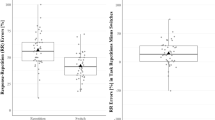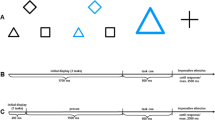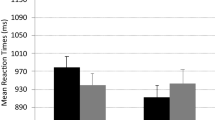Abstract
Under task switch conditions, response repetitions usually produce benefits if the task also repeats, but costs if the task switches. So far, it is largely undecided how to account for these effects. In the present study, we provide additional evidence in favor of the account that each response is inhibited in order to prevent its accidental re-execution. To test this hypothesis, the risk of an accidental re-execution of a given response was manipulated by modulating the activation of the response in the previous task. In Experiment 1, this was done by means of congruent and incongruent stimuli. As expected, on task switch trials, the repetition costs were larger if a congruent rather than an incongruent stimulus occurred in the previous task. In Experiment 2, the same effect occurred for stimulus-response compatible versus incompatible stimuli in the previous task. In Experiment 3, both manipulations were applied together, which produced almost additive effects. Altogether, the results support the inhibition account for the response repetition effects under task switch conditions.




Similar content being viewed by others
Notes
Here and in the following, we use the term “trial” even if actually effects within a trial (i.e. from a first to a second task in a dual-task or sequence procedure) were considered.
For the response times, the effects of congruency and SR-compatibility were additive, as could have been expected from the PDP models mentioned in the introduction (Botvinick et al., 2001; Gilbert & Shallice, 2002; Houghton & Tipper, 1994). With respect to the error rates, however, this was not the case. The reason for this interaction might though simply reflect a floor effect: Given a congruent stimulus, errors are already so infrequent that even if the stimulus was also compatible, this could not further improve performance.
References
Botvinick, M. M., Braver, T. S., Barch, D. M., Carter, C. S., & Cohen, J. D. (2001). Conflict monitoring and cognitive control. Psychological Review, 108, 624–652.
Brown, J. W., Reynolds, J. R., & Braver, T. S. (2007). A computational model of fractionated conflict-control mechanisms in task-switching. Cognitive Psychology, 55, 37–85.
Campbell, K. C., & Proctor, R. W. (1993). Repetition effects with categorizable stimulus and response sets. Journal of Experimental Psychology: Learning, Memory, and Cognition, 19, 1345–1362.
De Jong, R. (2000). An intention-activation account of residual switch costs. In S. Monsell, J. Driver (Eds.), Attention and performance XVIII: Control of cognitive processes (pp. 357–376). Cambridge: MIT.
De Jong, R., Liang, C. C., & Lauber, E. (1994). Conditional and unconditional automaticity: A dual-process model of effects of spatial stimulus-response correspondence. Journal of Experimental Psychology: Human Perception and Performance, 20, 731–750.
Egner, T., & Hirsch, J. (2005). Cognitive control mechanisms resolve conflict through cortical amplification of task-relevant information. Nature Neuroscience, 8, 1784–1790.
Eimer, M. (1995). Stimulus-response compatibility and automatic response activation: Evidence from psychophysiological studies. Journal of Experimental Psychology: Human Perception and Performance, 21, 837–854.
Forstmann, B. U., Brass, M., & Koch, I. (2007). Methodological and empirical issues when dissociating cue-related from task-related processes in the explicit task-cuing procedure. Psychological Research, 71, 393–400.
Gilbert, S. J., & Shallice, T. (2002). Task switching: A PDP model. Cognitive Psychology, 44, 297–337.
Hommel, B. (1993). Inverting the Simon effect by intention: Determinants of direction and extent of effects of irrelevant spatial information. Psychological Research, 55, 270–279.
Hommel, B. (1995). Stimulus-response compatibility and the Simon effect: Toward an empirical clarification. Journal of Experimental Psychology: Human Perception and Performance, 21, 764–775.
Hommel, B. (1998). Event files: Evidence for automatic integration of stimulus-response episodes. Visual Cognition, 5, 183–216.
Houghton, G., & Tipper, S. P. (1994). A model of inhibitory mechanisms in selective attention. In D. Dagenbach, T. H. Carr (Eds.), Inhibitory processes in attention, memory, and language (pp. 53–112). San Diego: Academic.
Hübner, R., & Druey, M. D. (2006). Response execution, selection, or activation: What is sufficient for response-related repetition effects under task shifting? Psychological Research, 70, 245–261.
Hübner, R., & Druey, M. D. (2007). Multiple response codes play specific roles in response selection and inhibition under task shifting. Psychological Research. (in press).
Kleinsorge, T. (1999). Response repetition benefits and costs. Acta Psychologica, 103, 295–310.
Kornblum, S., Hasbroucq, T., & Osman, A. (1990). Dimensional overlap: Cognitive basis for stimulus-response compatibility–a model and taxonomy. Psychological Review, 97, 253–270.
Logan, G. D., & Gordon, R. D. (2001). Executive control of visual attention in dual-task situations. Psychological Review, 108, 393–434.
Lu, C. H., & Proctor, R. W. (1995). The influence of irrelevant location information on performance: A review of the Simon and spatial Stroop effects. Psychonomic Bulletin & Review, 2, 174–207.
Mayr, U., & Kliegl, R. (2003). Differential effects of cue changes and task changes on task-set selection costs. Journal of Experimental Psychology: Learning, Memory, and Cognition, 29, 362–372.
Meiran, N. (2000a). Modeling cognitive control in task-switching. Psychological Research, 63, 234–249.
Meiran, N. (2000b). Reconfiguration of stimulus task sets and response task sets during task switching. In S. Monsell, J. Driver (Eds.), Attention and performance XVIII: Control of cognitive processes (pp. 377–399). Cambridge: MIT.
Meiran N. (2005). Task rule-congruency and Simon-like effects in switching between spatial tasks. The Quarterly Journal of Experimental Psychology, 58A, 1023–1041.
Meiran N., Chorev Z., & Sapir, A. (2000). Component processes in task switching. Cognitive Psychology, 41, 211–253.
Notebaert W., & Soetens, E. (2003). The influence of irrelevant stimulus changes on stimulus and response repetition effects. Acta Psychologica, 112, 143–156.
Notebaert W., Soetens E., & Melis, A. (2001). Sequential analysis of a Simon task––evidence for an attention-shift account. Psychological Research, 65, 170–184.
Pashler H., & Baylis, G. (1991). Procedural learning: 2. Intertrial repetition effects in speeded-choice tasks. Journal of Experimental Psychology: Learning, Memory, and Cognition, 17, 33–48.
Ridderinkhof, K. R. (1997). A dual-route processing architecture for stimulus-response correspondence effects. In B. Hommel, W. Prinz (Eds.), Theoretical issues in stimulus-response compatibility (pp. 119–131). Amsterdam: Elsevier.
Ridderinkhof, K. R. (2002). Micro- and macro-adjustments of task set: Activation and suppression in conflict tasks. Psychological Research, 66, 312–323.
Rogers, R. D., & Monsell, S. (1995). Costs of a predictable switch between simple cognitive tasks. Journal of Experimental Psychology: General, 124, 207–231.
Schuch, S., & Koch, I. (2004). The costs of changing the representation of action: Response repetition and response-response compatibility in dual tasks. Journal of Experimental Psychology: Human Perception and Performance, 30, 566–582.
Simon, J. R. (1969). Reactions toward the source of stimulation. Journal of Experimental Psychology, 81, 174–176.
Smith, M. C. (1968). Repetition effect and short-term memory. Journal of Experimental Psychology, 77, 435–439.
Soetens, E. (1998). Localizing sequential effects in serial choice reaction time with the information reduction procedure. Journal of Experimental Psychology: Human Perception and Performance, 24, 547–568.
Soetens, E., Melis, A., & Notebaert, W. (2004). Sequence learning and sequential effects. Psychological Research, 69, 124–137.
Steinhauser, M., & Hübner, R. (2006). Response-based strengthening in task shifting: Evidence from shift effects produced by errors. Journal of Experimental Psychology: Human Perception and Performance, 32, 517–534.
Stürmer, B., Leuthold, H., Soetens, E., Schroeter, H., & Sommer, W. (2002). Control over location-based response activation in the Simon task: Behavioral and electrophysiological evidence. Journal of Experimental Psychology: Human Perception and Performance, 28, 1345–1363.
Stürmer, B., Seiss, E., & Leuthold, H. (2005). Executive control in the Simon task: A dual-task examination of response priming and its suppression. European Journal of Cognitive Psychology, 17, 590–618.
Wühr, P., & Ansorge, U. (2005). Exploring trial-by-trial modulations of the Simon effect. The Quarterly Journal of Experimental Psychology, 58A, 705–731.
Acknowledgments
We are grateful to Nachshon Meiran, Iring Koch, and an anonymous reviewer for their helpful comments on a previous version of this manuscript. Furthermore, we thank Johannes Schult and Karen Donath for collecting the data. This research was supported by a grant (Hu 432/9) from the Deutsche Forschungsgemeinschaft (DFG) to the second author.
Author information
Authors and Affiliations
Corresponding author
Rights and permissions
About this article
Cite this article
Druey, M.D., Hübner, R. Response inhibition under task switching: its strength depends on the amount of task-irrelevant response activation. Psychological Research 72, 515–527 (2008). https://doi.org/10.1007/s00426-007-0127-1
Received:
Accepted:
Published:
Issue Date:
DOI: https://doi.org/10.1007/s00426-007-0127-1




